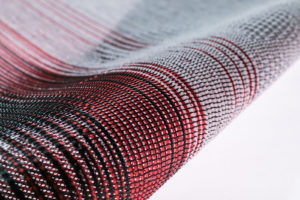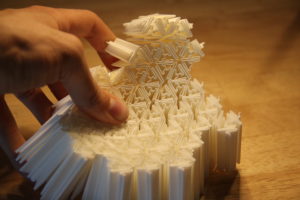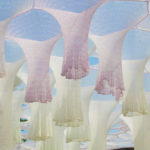From raw materials to manufacturing processes, the word “textile” takes on new meanings.
Textile technology is undergoing a revolution, with innovative structures, raw materials and manufacturing platforms creating new fabrics that defy old-school definitions. Introductory textile science classes taught us that textiles were materials that could be woven, knit, crocheted, knotted or felted from yarns spun from cellulose, protein or petroleum-based synthetic fibers. Today a new generation of consumer textiles is being driven by trends such as digitization, customization, sustainability, performance, and speed-to-market.

Additive manufacturing models, including three dimensional (3D) knitting and printing, molding, bonding and lamination—along with a raft of new raw materials, such as biosynthetics, foam and composite structures—are disrupting the known world of textiles, creating a knowledge base that is rapidly expanding from consumer products into the wider world.
The ruckus over Team GB’s skeleton suits at the 2018 Pyeong Chang Olympics brought home the fact that this new breed of textiles goes way beyond yoga pants. Developed by engineering consultants TotalSim and the English Institute of Sport, the skeleton team’s “skinsuits” were made from a polyurethane derivative and featured aerodynamic ridges, reducing wind resistance. Each athlete was custom-fitted via a 3D laser-scan.
The footwear revolution
The launch of knitted shoe uppers by Nike and adidas in 2012 raised the bar for athletic footwear design and fueled the development of new methods of manufacturing that eliminated steps in the supply chain

and reduced material waste. The flatbed knitting machines used to create footwear uppers employed digital design to customize complex dimensional knit structures, instead of knitting individual pieces that required sewing. The technology is now being adopted for use in areas such as architecture or automotive applications.
For example, in 2017 home furnishings retailer Ikea launched 3D knit chairs using the new knitting technology. Bloomsburg News recently reported that Shima Seiki Manufacturing Ltd., which pioneered digital WHOLEGARMENT® knitting, is in talks with major auto-parts suppliers to develop lightweight knit components that could replace steel.

But there’s more. Reebok’s Flexweave™ was designed as a woven structure for lightweight, breathable, customizable shoe uppers. The unique open figure-8 construction integrates raw materials, such as chenille yarns for softness and thermoplastic elastomer (TPE) yarns for lightweight stability, with the potential to add spandex or high-tenacity fibers such as Kevlar® to the mix. Flexweave woven fabric is now being engineered into a classic suit, an athletic chair, gloves and a training mask.
3D knitted architecture
Working with Shima Seiki WHOLEGARMENT® 3D knitting machines and photo-luminescent, solar-active, and recycled yarns, architect Jenny Sabin’s structures exhibited at the Cooper Hewitt Design Triennial in 2015–2016, and in 2017at the Museum of Modern Art (MoMA) PS1 in Long Island City, New York.
Sabin’s Lumen installation, comprising thousands of digitally knitted cells in stalactite conical forms, won MoMA’s 2017 Young Architects Program. She describes her structures as inspired by nature and mathematics, saying that Lumen operates as an environment, integrated with its context (read more about it).
Reimagining materials
Raw material innovation is also moving at an unprecedented pace. Biosynthetic polymers, derived wholly or partly from renewable resources such as sugars, starches, and plant oils; biomass from cellulosic plant waste; or algae, fungi or bacteria; are forecast to comprise 22 percent of all chemical sales by 2020, according to the European Commission.
With sustainability top-of-mind, the potential of biosynthetics is worth further exploration, and Textile Exchange has just launched a website, aboutbiosynthetics.org, that begins the process.
While foam has become somewhat ubiquitous as a component of footwear, home furnishings and protective equipment, recent developments in a polymer known as thermoplastic polyurethane (TPU) from chemical companies such as BASF, Huntsman and Lubrizol are also changing the game.
TPUs are extremely versatile, exhibiting elasticity and durability, and can be melt-processed, making them ideal for footwear components and performance textiles. Most importantly, they can be blown into foam; creating a light weight, easily processed material that’s ideal for midsoles and other end uses where weight, cushioning, impact resistance, insulating qualities, and breathability are key.
Lubrizol’s BounCell-X™ is a low density, plasticizer-free, recyclable foam made from Lubrizol’s Estane® TPU. Kenneth Kim, Lubrizol North American market development manager for footwear, describes the manufacture of BounCell-X as a clean process which employs nitrogen gas as a physical blowing agent to create a microcellular foam.
Importantly, the process leaves no chemical residue within the polymer, allowing the product to be recycled within the original polymer classification.
Abrasion-resistant materials similar to rubber can be formed from another material, Lubrizol’s Estane TPU TRX, which are compatible with “over molding” of softer BounCell-X foam components, eliminating the need for solvent-based adhesives in footwear and other manufacturing processes. In addition, Lubrizol’s Esdex TPU yarns can be knit or woven in shoe uppers or other textiles, and thermally customized for different levels of flexibility, comfort and reinforcement.
“The ‘green’ story is huge,” says Lalith Suragani Venu, Lubizol’s application scientist, performance apparel & footwear. While traditional foams must be cut to shape and require the use of cements or adhesives during manufacturing, “Lubrizol TPU foams and yarns can be bonded or customized through thermoforming, while maintaining flexibility, breathability and antibacterial properties.”
3D printing pro’s and con’s
TPU’s strength and elastomeric properties are finding additional application in the development of materials for 3D printing. Lubrizol Corp. recently announced a collaboration with HP in their Open Materials and Applications Platform to explore the development of its Estane TPU polymers in fused deposition printing processes.
3D printing (3DP), which deposits or “prints” layers of a raw material from a digital program, has been touted as the future of textiles. Footwear brands including adidas, Nike, New Balance, and Under Armour have already successfully adopted 3DP for components, such as outer and midsoles, in their athletic shoes.
High-end designers such as Iris van Herpen and Gabi Asfour have launched 3DP apparel on the runway. But unlike traditional woven or knit textiles which allow yarns to slip and move within the structure, 3DP fuses the raw materials together, making garments stiff, scratchy, and brittle. Until recently, development of raw materials for 3DP with the flexibility and robustness needed for apparel has been slow.
3D real fabric
Designer Danit Peleg has been advancing the progress of 3DP textiles since her 2015 graduate collection of 3DP garments for Shenkar University garnered international attention. Peleg’s breakthrough came when she found FilaFlex, a flexible 3DP filament created by Spanish company Recreus and made from TPE.

The inspiration for Peleg’s lace-like structures came when she connected with Andreas Bastian and his Mesostructured Cellular Materials. The geometry of Bastian’s 3DP mesostructures increases their ability to stretch or compress, relying on structure rather than raw materials for their flexibility. Adapting Bastian’s geometric structures enabled Peleg to develop 3DP fabric with the necessary flexibility to create wearable garments.
“When you touch my fabric, it is not like anything you have felt before. It’s so similar to ‘real fabric.’ For me, it is real fabric,” she says.
Peleg credits a creative partnership with Gerber Technology, a supplier of hardware and software to the fashion business and many other industries, with enabling her to create the digital patterns for her designs. She’s worked with Gerber to improve their ground-breaking AccuMark® pattern-making and 3D visualization software.
In 2017 Peleg launched a platform on her website which allows customers to personalize and order a 3DP garment online. And while 3DP one-offs aren’t inexpensive, her goal is that consumers will soon be able to download design files in order to customize and print a 3D garment in a shop or even in their own homes.
“Customers are becoming more curious about the provenance and sustainability of their fashion,” she says. “Fashion is becoming like the music industry. Designers will no longer need a physical store.”
She also points out that the plastic polymers used in 3DP textiles can easily be recycled at home. A

company called Filabot makes desktop extruders that melt plastic waste such as a cut-up 3DP dress or scrap material, then extrudes it as usable filament for the next project, enabling fast-fashion addicts to 3DP a garment at home for “one night only” and then recycle it.
Bastian envisions other end uses for his 3DP structures as well.
“Architects could have much more flexibility in the variety of curved surfaces with which they could compose a building’s façade,” Bastien said in a 2014 edition of the online journal 3DPrint.com. “Likewise, composite body panels used in boat hulls and automotive bodies could be fabricated using mesostructures as the core material, enabling more complex curvature.”
From knitted footwear and architecture, from future materials to 3D printing, it’s undeniable that these new definitions of “textiles” will challenge the industry at large to keep pace.
Debra Cobb is a freelance writer based in Greensboro, N.C, with extensive experience in the textiles industry. She is a regular contributor to Advanced Textiles Source.
 TEXTILES.ORG
TEXTILES.ORG




